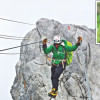The Great East Himalayan Trek

WHEN DREAMS COME TRUE
It was around 7 in the morning. A chilly breeze from the north was freezing us to our very core. The multi-coloured Tibetan prayer flags were fluttering from the strong wind sweeping over the whole plateau. We were standing on top of Sandakphu, the highest peak in the Indian state of West Bengal. Standing above 12000 feet from the sea level, it's not the subzero temperature but theincessant winds that makes one shiver. Four of us were standing bewildered; in front of us, there was "the sleeping Buddha" – the mighty Kanchenjunga, the third highest peak in the world. To our left, deep into the Western Himalayas stood a scintillating horizon – a series of 8000 meter peaks, the highest in the world, among which was the magnificent Everest.Yes, seeing the highest mountain on the planet with my own eyeswas an overwhelming experience. When childhood dreams turn into realities, there's nothing more you can ask for.
THE START OF AN EPIC JOURNEY
The bus for Siliguri was two hours late. We had some light snacks and bought some more, to get us through the night. We were four friends, all of us new to India. So along with the thrills of adventure, there were apprehensions whether we could do this or not. The journey to Siligurifrom Nadia took around 17 hours.
SILIGURI, AT LAST
Upon reaching Siliguri, concluding what had been a very bumpy bus ride, we ran for food. We were hungry beyond measure, and were gulping down omelettes without a word. After a hearty breakfast, we went to meet our local contact, a jolly man named JeevanChitrey. The man drew for us a map of our trek-route, arranged for us a hotel at the access-town for the trek,Maneybhanjan, and got us on a shared SUV bound for the town.
From the back-seat of a jam-packed vehicle, we watched the captivating surroundings while gently gaining elevation along the serpentine roads. The local dialect was pleasing at first, but started getting tiresome soon. However, we looked for comfort in the surrounding breathtaking mountainous terrains.
THE LITTLE TOWN OF MANEYBHANJAN
When we got down at Maneybhanjan, it was almost afternoon. We roamed for couple of hours around the little town. There were Buddhist monasteries and little schools for kids. When I close my eyes and think of that little town now, I remember colours – bright red, blue, green, orange and yellow. We stood at the edge of a massive ground, and looked at the valleyunderneath. In front of us there were converging layers of mountains. One starts to feel trivial when in the presence of nature's magnificence. It humbles you, to say the least.
For every trek, there is an access-town or point from where the journey begins. Maneybhanjanis the access-town for the great Sandakphu trek, the entry point of the Singalila National Park.
THE GREAT TREK AND BEYOND
It took us almost three days to reach Sandakphu and one more day to get down. We were trekking through some of the most beautiful trails in the Eastern Himalaya. Our guide Shyam knew the place very well and showed us around. The trek took us through some of the fascinating conifer, pine and oak forests; across cable-stayed bridges over fast-flowing streams; and also barren mountainous regions. It was early February, so there weren't many rhododendrons in sight, but whatever we saw of the red flowerdelighted us.
The Sandakphuis a basic trek that one can do if the plan is to venture into more elaborate and strenuous treks in the Himalayas. It's a moderately difficult trek covering 50kilometres in the span of four days. The last day of the trek may seem a tad challenging as it involves descending almost 5000ft in a matter of a day, but it's the most rewarding day of the trek actually. You trek down through dense forests where the overlying canopy of treesis blurred by white smog-like clouds.
There are small communities in between the daily course of your trek, where you can get food and accommodation easily. The local Tibetan and Gorkha people are really friendly and hospitable. The trek itinerary is as follows:
Day 1: Maneybhanjan – Chitrey – Lameydhura – Meghma-Tumling
Day 2: Tumling – Gairybas – Kaiyakatha-Kalapokhri
Day 3: Kalapokhri-BikheyBhanjan-Sandakphu
Day 4: Sandakphu – Gurdum – Sirikhola-Seppi
From Seppi, you can return back to Siliguri in a shared car-ride in 5/6 hours.All of these unfamiliar names are little local communities scattered across the mountains. There are trekker huts where you can stay for minimal cost (150-200 rupees/person/night). The food is also great and you can trythe sumptuous Tibetan cuisine.
The best seasons to trek Sandakphu are April-May and October-November, that is, before and after monsoon, because in these months the weather is great, the visibility is excellent and the trails are surrounded by heavily-clad bright red, blooming rhododendron bushes.
Though we went from Krishnanagar, you can go to Siliguri via the Burimary land-port and from the Indian side of border, you can easily board a bus or shared SUV which will take you to Siliguri, and the journey will take around 2 hours.

 For all latest news, follow The Daily Star's Google News channel.
For all latest news, follow The Daily Star's Google News channel. 






Comments